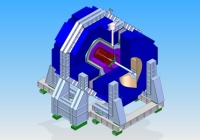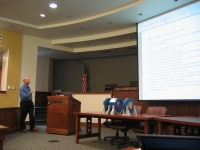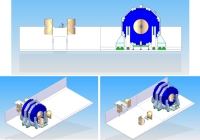 |
 |
|||||||||||||
|
|||||||||||||
|
|||||||||||||
|
The third SiD Workshop this year, hosted from 17 to 19 September by the University of Colorado at Boulder, marked an important milestone on SiD's way to the Letter of Intent (LOI): the collaboration froze its detector’s global parameters. The meeting was opened by Barry Barish, who reminded everyone that the "science remains the key to ultimate success" of the ILC programme and that detector development was critical. Given the difficult times for ILC funding both for accelerators and detectors, the meeting included updates on the current funding situation worldwide and on the status in France, Japan, the UK and the US. SiD additionally invited two guest speakers, Howard Nicholson from the US Department of Energy Office of High Energy Physics and Marvin Goldberg from the National Science Foundation, to give the audience an update of the US situation and the view from Washington. John Jaros then reviewed goals for the meeting: sharpen our vision of what the LOI is, define what needs to be done, assign work, and enlist authors. We also reviewed the optimisation process and the final SiD global parameters. The updated SiD detector concept comes with a new HCAL design, which features forty layers and a total of 4.5 lambdas (~ 0.75 m) of steel absorber. Additionally there were agreements on an impressive set of minor corrections and improvements in the new detector design. We had discussed this new layout intensively the weeks before, and at the workshop in Boulder all participants gave the design the final sign-off. In parallel to the efforts of finalising the global parameters, the engineering design group showed huge progress in making a realistic and mechanically sound design of SiD. This design supports the push/pull approach, incorporates all the shielding requirements as well as those for machine-detector-interface. The mass production of the required Monte-Carlo samples using the new model has started and several ten million events have already been produced - a milestone for the benchmarking effort. With the benchmark analyses gearing up, the reconstruction group announced that they had reached two milestones: full and efficient pattern recognition for silicon tracking and a working (and competitive) particle flow algorithm for SiD. The upcoming physics benchmarks will be conducted using these elements of the SiD reconstruction suite. An important part of the Boulder workshop were the breakout sessions where the individual subsystems finalised their plans towards the LoI. These informal discussions in small groups were considered quite useful by all the participants and will be a very welcome addition to future SiD Workshops as well. In his closing talk, Harry Weerts summarised that “we are on our way and this workshop was a big positive step towards the LoI.” -- Marcel Stanitzki |
|||||||||||||
| © International Linear Collider |


